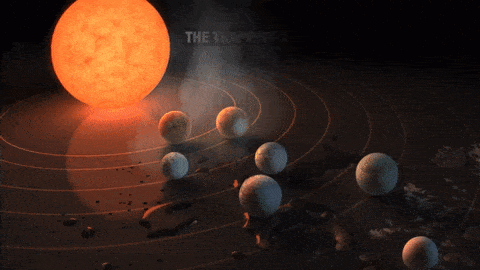
Formation of Planetary Systems
Quiz
•
Science
•
8th - 12th Grade
•
Practice Problem
•
Medium
+6
Standards-aligned

Clint Sandford
Used 259+ times
FREE Resource
Enhance your content in a minute
20 questions
Show all answers
1.
MULTIPLE CHOICE QUESTION
45 sec • 1 pt

Astronomers use _____ of the origin of the solar system based on current observations.
scale drawings
models
experimental theories
their knowledge
Tags
NGSS.HS-ESS1-6
2.
MULTIPLE CHOICE QUESTION
45 sec • 1 pt

Our solar system with 8 known major planets, asteroids & comets may or may not be
as large as astronomers think it is.
as full of gas & dust as other solar systems.
correct.
unique.
Tags
NGSS.MS-ESS1-3
3.
MULTIPLE CHOICE QUESTION
30 sec • 1 pt

In science, all _____ can change or become modified with new discoveries.
theories
knowledge
history
reality
Tags
NGSS.HS-LS4-1
NGSS.HS-PS1-2
4.
MULTIPLE CHOICE QUESTION
1 min • 1 pt

In our solar system, all major planets lie (roughly) in the same ____ & orbit in the same ____.
plane, direction
direction, plane
space, direction
area, space
Tags
NGSS.MS-ESS1-2
5.
MULTIPLE CHOICE QUESTION
1 min • 1 pt

The fact that all of the planets orbit in the same direction as the Sun rotates indicates that
the solar system is 5 billion years old.
there is no such thing as retrograde motion.
they all formed at about the same time & relative space.
Pluto may have formed somewhere else.
Tags
NGSS.MS-ESS1-2
6.
MULTIPLE CHOICE QUESTION
1 min • 1 pt

Which statement best describes the terrestrial planets?
no or very few moons; solid surfaces; moderate atmospheres
no moons; non-solid surfaces; hot atmospheres
many moons; solid surfaces; extreme atmospheres
they all orbit pretty close in to the Sun
7.
MULTIPLE CHOICE QUESTION
45 sec • 1 pt

Why do terrestrial planets have high densities and solid surfaces?
because they are made of rock
heavier elements were blasted away by the Sun
lighter elements were stripped away by the Sun
no one really knows
Tags
NGSS.MS-ESS2-1
NGSS.MS-ESS2-2
Create a free account and access millions of resources
Create resources
Host any resource
Get auto-graded reports

Continue with Google

Continue with Email

Continue with Classlink

Continue with Clever
or continue with

Microsoft
%20(1).png)
Apple
Others
Already have an account?
Similar Resources on Wayground

20 questions
Methods of Heat Transfer
Quiz
•
7th - 9th Grade

15 questions
Theories on the Origin of the Universe
Quiz
•
11th Grade

15 questions
Rock cycle/classification
Quiz
•
11th Grade

15 questions
Air, Respiration & Pollution
Quiz
•
8th - 9th Grade

20 questions
Compounds: Formulas and Names
Quiz
•
12th Grade

18 questions
Inner Solar System
Quiz
•
8th Grade

20 questions
Astronomia - 9A
Quiz
•
9th Grade

17 questions
What do plant cells need?
Quiz
•
6th - 8th Grade
Popular Resources on Wayground

5 questions
This is not a...winter edition (Drawing game)
Quiz
•
1st - 5th Grade

15 questions
4:3 Model Multiplication of Decimals by Whole Numbers
Quiz
•
5th Grade

25 questions
Multiplication Facts
Quiz
•
5th Grade

10 questions
The Best Christmas Pageant Ever Chapters 1 & 2
Quiz
•
4th Grade

12 questions
Unit 4 Review Day
Quiz
•
3rd Grade

10 questions
Identify Iconic Christmas Movie Scenes
Interactive video
•
6th - 10th Grade

20 questions
Christmas Trivia
Quiz
•
6th - 8th Grade

18 questions
Kids Christmas Trivia
Quiz
•
KG - 5th Grade
Discover more resources for Science

20 questions
Convection, Conduction, and Radiation
Quiz
•
6th - 8th Grade

10 questions
Exploring the Energy Cycle: Photosynthesis and Cellular Respiration
Interactive video
•
6th - 10th Grade

23 questions
Newton's 3 Laws of Motion
Quiz
•
8th Grade

22 questions
Rock Transformations Amplify Final Test
Quiz
•
6th - 8th Grade

37 questions
8.10B Weather Patterns
Quiz
•
8th Grade

15 questions
Domain 3 – Classification: 15-Question Assessment
Quiz
•
9th Grade

10 questions
Exploring Plate Tectonics and Their Boundaries
Interactive video
•
6th - 10th Grade

15 questions
Domain 4 – Evolution: 15-Question Assessment
Quiz
•
9th Grade



